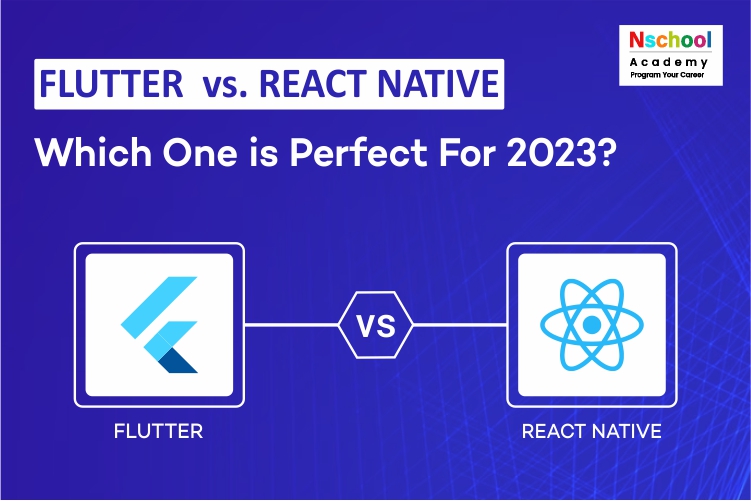- February 3, 2023
- nschool
- 0

Flutter vs. React Native Which One is Perfect for 2023?
Flutter and React Native are separate mobile programming frameworks that serve different objectives. Flutter focuses on creating fast, responsive apps, whereas React Native provides native-like experiences for Android and iOS. Everything is easily available on these mobile applications, from purchasing products to making queries, and a pleasant user interface improves the customer experience.
This post will compare Flutter vs. React Native to address one of the most pressing challenges for business success through app development. The fact that 92% of mobile users prefer mobile apps to web browsers is reason enough for business owners to focus on mobile app development to ensure they have the potential to attract customers through several channels. Flutter and React Native will be the most popular cross-platform app development platforms in 2023, with their popularity growing consistently.
What are the benefits of using Flutter?
Flutter is an open-source framework for designing and delivering native apps for Android and iOS that was created by Google and formally launched in December 2018. This platform combines development and performance simplicity while maintaining visual purity.
Flutter is a free and open-source platform that uses the “Dart” programming language to replace Javascript. Because Flutter enables cross-platform apps from a single codebase, organizations may build an application that will be available on the web, mobile, and desktop using a single tool. Flutter-created apps are more intuitive and user-friendly, making them a popular choice for companies with significant foundation requirements, such as Alibaba, eBay, and Google Assistant.
How does Flutter perform?
The structure of Flutter is made up of a flutter engine, a foundation library, and widgets. Because of its declarative UI authoring, which compels you to start from the end, Flutter’s approach to app development is unique. As a result, the user must clearly understand what UI it will be before building any element.
Developers may create the whole user interface by combining various widgets. Flutter also enables developers to create custom widgets that may be coupled with pre-existing ones. Flutter also includes a slew of software packages that provide access to Firebase and Redux data warehouses, enhancing the user experience by expanding application possibilities.
What is React Native?
React Native is a popular javascript-based mobile framework that allows for creating natively rendered mobile apps for Android and iOS from a single codebase. In 2015, Facebook made it available as an open-source project. React-native has swiftly gained popularity as a top mobile app development platform, with notable examples including Instagram, Facebook, and Skype. It saves both time and resources because it just involves generating code once.
How does React Native function?
Javascript and JXL are combined in React Native (unique code resemblant of XML). This framework allows you to connect to both Javascript and native application threads. This cross-platform programming approach does not use web views in its code, instead relying on pre-existing native concepts and components. React-native allows bidirectional communication by linking the javascript and native lines.
Advantages of Flutter
Similar UI across platforms: Flutter’s user interface and business logic are the same on Android and Apple devices, resulting in a consistent experience independent of the operating system. This feature is critical, especially for companies with strong corporate identities.
Customized Design: Skia, an open-source, high-performance graphics engine used by Adobe, Chrome, and Amazon Kindle, is included in Flutter. Users may use this advanced tool to develop custom-designed programs that function on both iOS and Android devices. Furthermore, the likelihood of UI issues during software updates has been eliminated.
Quick Coding with Hot reloads: As one of the most current platforms for app development, this technology allows for rapidly creating high-performance apps. The platform saves time by allowing the developer to see changes in real-time, resulting in enhanced efficiency and productivity. Flutter’s hot reload functionality exceeds competitors’ comparable capabilities by allowing developers to pause code execution, make code changes, and restart coding from the same position, resulting in remarkable speed.
Widgets and Minimal Coding: The use of pre-built apps in Flutter is an important feature that enables a consistent development and design approach. These Google-based widgets have superior code quality and perform better than other open-source frameworks. Many of them are customizable, with materials and Cupertino designs that offer significant advantages. Dart, Flutter’s coding language, is embedded directly into mobile phones’ ARM code, speeding up apps and enabling speedier launch. With third-party interoperability and a native codebase, Flutter alleviates developer worry.
Advantages of React Native:
Simplified UI: React native offers a simple and uncomplicated user interface. Its design resembles that of an open-source network rather than a standard network. To assure optimal app sequencing, this platform leverages a software interface to remove extraneous functionality. Apps designed using react native feature a smoother user experience, a more responsive UI, and load faster.
Modular architecture: Developers may quickly modify or update programs thanks to a modular design and architecture. React Native’s user-friendly interface allows other developers to go deep into someone else’s project to build on it or make changes. Furthermore, testers devote less effort to comprehending software logic and creating appropriate test scenarios.
Optimal performance: Improving performance through native modules and controls is the key to establishing a platform’s efficacy. Before creating native API codes, React Native interacts with native iOS and Android components—using completely distinct threads from native APIs and UIs in React Native leads to performance boosts and improvement.
Live with Hot reloading: The live reloading feature facilitates the compilation and reading of programmers’ adjustments. It also provides the simulator with a new file that launches the application automatically. Hot reloading allows the developer to inspect changes in the source code even if the application is not recompiled. This React Native feature allows the developer to quickly see the consequences of code changes, resulting in little waiting time.
There are some essential differences between Flutter & React Native:
- Dart is the programming language used by Flutter, whereas React Native uses JavaScript. Dart is a new computer language designed for performance that is considered more efficient than prior programming languages such as Java or Python. However, because many developers use Flutter and React Native, this may not be the case for everyone.
- Because Flutter eliminates the need to code for iOS and Android platforms, creating a Flutter app is far faster than creating a React Native app. Instead, you write code specific to one platform or the other, and Flutter handles the rest (including optimizing the code). It enables faster and more efficient app creation by eliminating the need to understand two distinct programming languages.
- The ecosystem of React Native is more robust than that of Flutter. More third-party libraries and tools will be available to help you create faster and more efficient apps. However, Flutter supports several popular libraries, like Material Design and Firebase.
- React Native supports more devices than Flutter. It means you can create an app that works on Android and iOS devices, as well as macOS and Windows. On the other hand, Flutter is only available for Android and iOS devices.
- React Native offers a more comprehensive development experience than Flutter. It means you’ll be able to find additional lessons and resources online to help you learn how to create complicated apps using React Native. Flutter, on the other hand, is fast increasing, and a wealth of tools are already available to help you get started with this mobile programming framework.
| Concept | Flutter | React Native |
| Develop By | Google, May 2017 | Facebook, June 2015 |
| Programming Language | Flutter is built on the Business Logic Component (BLoC) architecture. | React Native uses Flux and Redux architectures. Facebook created flux. However, Redux is the preferred solution among the community. |
| Documentation | The documentation for Flutter is better, more organized, and more useful. Everything we require may be written in one place. | The React Native documentation is user-friendly yet disorganized. |
| Performance | The Flutter application is speedy. Flutter constructs the application with the arm C/C++ library, bringing it closer to machine code and improving native performance. | The React Native app operates slowly as compared to the Flutter app. Developers may run across issues while using the hybrid application design. |
| Testing | Flutter provides a wealth of testing options. This feature allows the developer to do unit, integration, and widget testing. | For app testing, React Native makes use of third-party technologies. |
Is Flutter or React Native easier to learn?
React Native Course and Flutter Course are simple to comprehend (in terms of APIs), albeit this will depend on the developer’s background. Both have a strong development community that may help new developers and is always creating new tools and components. For a brand-new developer with little or no coding experience, we would probably recommend starting with React Native because it comes with a set of predefined components that can be used to build iOS and Android apps, allowing you to learn one thing at a time without having to worry about learning all the APIs used for rendering views. Nschool Academy in Coimbatore offers Flutter Course and React Native Course with real project and placement support.
Conclusion:
There is no clear winner between Flutter and React Native regarding various characteristics. Because each project is unique, the optimal framework depends entirely on your project specs and business objectives. The competition to create the best mobile app development platform is on, and React Native looks to be on top. Meanwhile, Flutter remains a viable option for developers wishing to quickly and efficiently construct high-quality apps. However, as React Native becomes more popular, Flutter will likely become obsolete. Flutter Course and React Native courses are available at Nschool Academy in Coimbatore, as well as real-world project and placement support. So, if you’re contemplating investing in a platform for your next project, keep React Native and Flutter in mind.

